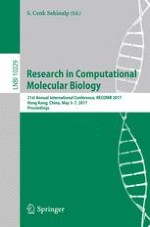2017 | Buch
Research in Computational Molecular Biology
21st Annual International Conference, RECOMB 2017, Hong Kong, China, May 3-7, 2017, Proceedings
herausgegeben von: S. Cenk Sahinalp
Verlag: Springer International Publishing
Buchreihe : Lecture Notes in Computer Science
